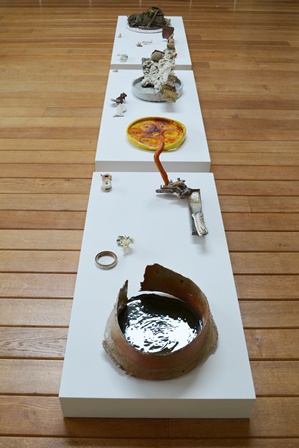Neil Brownsword’s ceramic installations present a socio-political commentary on the decline of the British ceramic industry in his home town of Stoke-on-Trent. The industrial area became a centre of ceramic production in the early seventeenth century because of the local availability of clay, lead, coal and salt. Adopting the role of both artist and archaeologist, Brownsword unearths discarded byproducts from the closed Staffordshire potteries and uses these materials to create sculptures. His work reflects on the inevitable effects of global capitalism which continue to disrupt indigenous skills and a heritage economy rooted in North Staffordshire for nearly three centuries.
Waster (2011) is comprised of detritus that Brownsword has salvaged from various shutdown ceramic factories in Stoke-on-Trent. He has glazed and re-fired this material, fusing it together with ‘shraff’ or ceramic landfill, and has composed these transformed fragments into a sculpture that cite taxonomies of industrial archaeology. The title of the work directly references the term ‘waster’, which is used in this industry to describe a broken or ‘failed’ object which is subsequently discarded.
It was the collections of The Potteries Museum & Art Gallery, based in Stoke-on-Trent, that specifically inspired Brownsword to make Waster. The Potteries has a renowned collection of Staffordshire ceramics and at the same time remains a key repository for the archaeology of the pottery industry in the region. The acquisition of Waster is an important update of the museum’s existing holdings, showing how ceramics and pottery have stretched into the contemporary realm. The acquisition of Brownsword’s installation also strengthens one of the museum’s collections priorities to support local artists with a link to the pottery industry.


